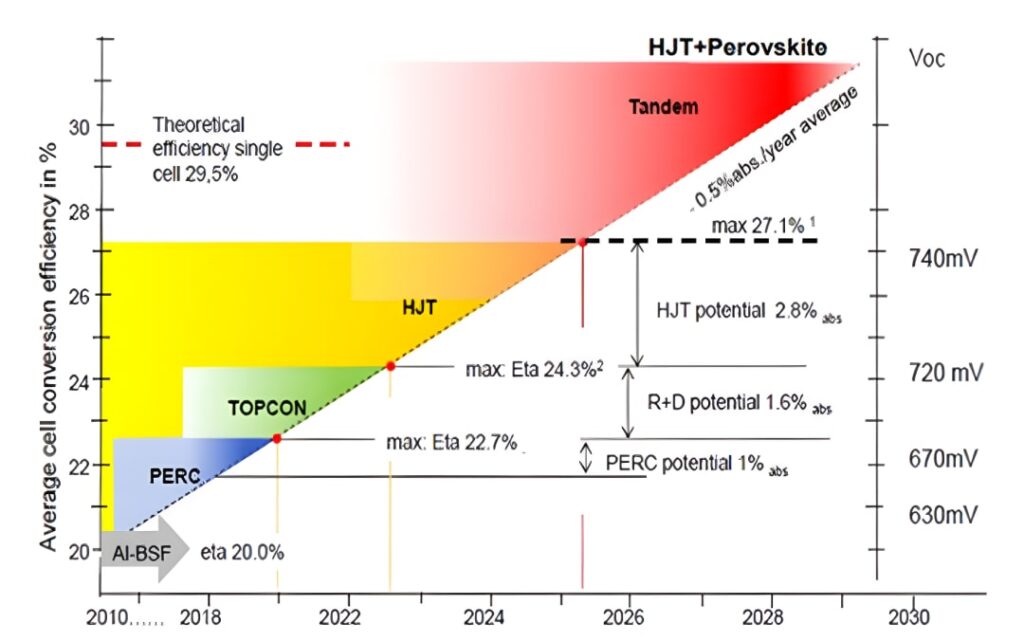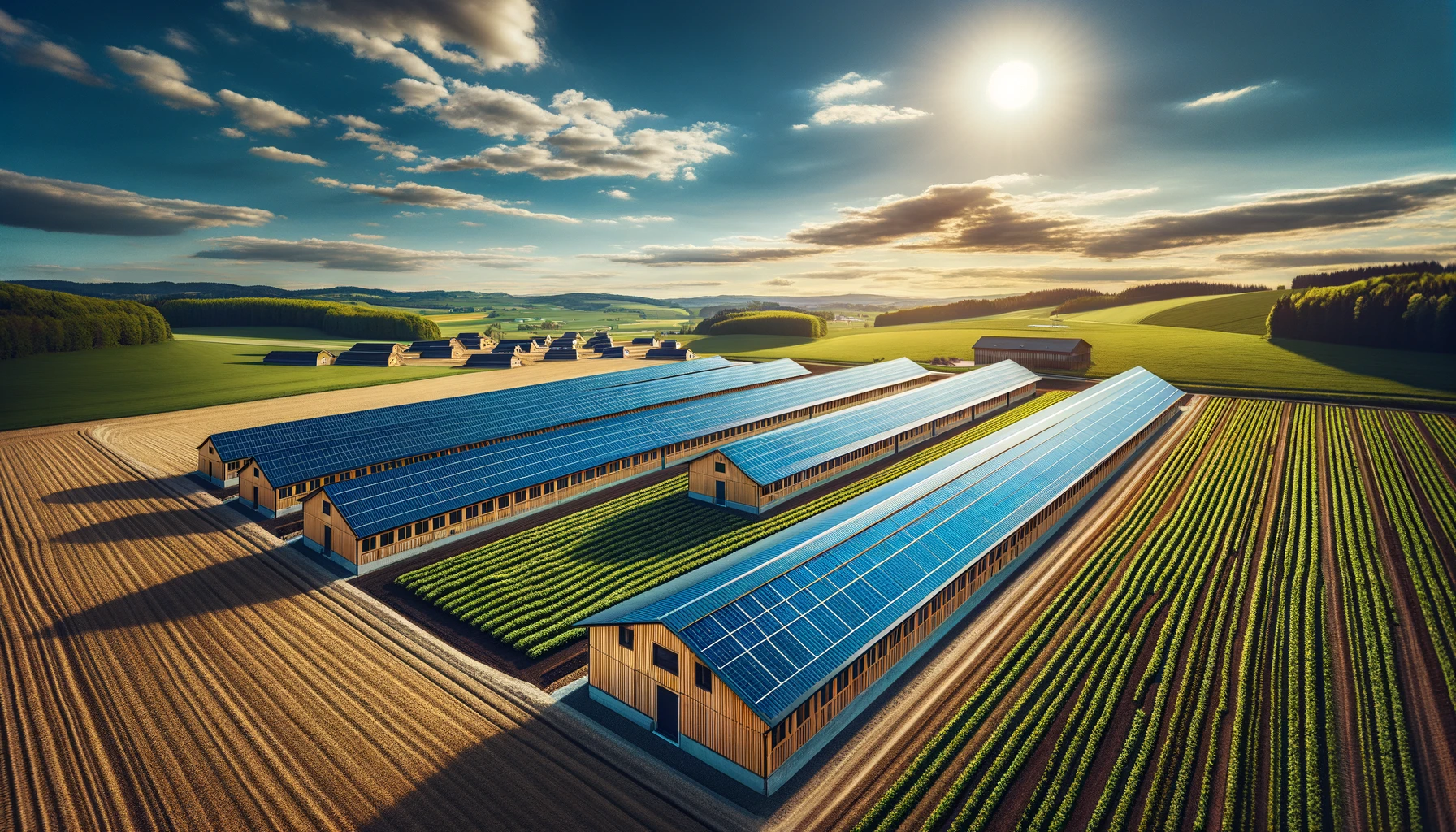
The Heterojunction: A revolutionary solar technology for a sustainable future
Have you ever heard of heterojunction technology in the solar world? Facing the climate emergency, the world is mobilizing to adopt clean energy alternatives, making solar energy a key player in the march towards a sustainable future. At the heart of this revolution, heterojunction stands out as a promising technological advance, pushing the performance of solar panels even further.
In this rapidly changing environment, the adoption and integration of heterojunction by certain industry players offer advanced solar solutions, reflecting the state of the art in the field.
This article takes you to the heart of heterojunction, revealing its crucial role in shaping an innovative solar future and its promises of an energy revolution.
Table des matières
What is heterojunction?
Heterojunction (HJT), corresponds to the terms “Heterojunction Technology”. It’s not just an advancement; it’s a revolution in the photovoltaic world. Heterojunction Technology (HJT) cleverly integrates crystalline silicon, traditionally used in solar cells, with thin-film technologies to enhance efficiency and energy performance. This fusion broadens the spectrum of captured light and reduces charge recombination losses, resulting in a significant increase in the conversion of solar energy into electricity, thus optimizing energy production even in low light conditions.
What distinguishes HJT is its ability to exploit a broader solar spectrum, thus optimizing the conversion of light into electricity more efficiently than traditional methods such as monocrystalline and polycrystalline silicon, perovskites, and CIGS (Copper Indium Gallium Selenide). While monocrystalline silicon already offers high efficiency, HJT enhances it with additional layers that capture more solar light. Compared to polycrystalline silicon, which is less expensive but less efficient, HJT uses a combination of amorphous and crystalline silicon to improve performance.

Moreover, while perovskite solar cells offer high-efficiency potential and low production cost, HJT surpasses them in terms of stability and lifespan. Similarly, compared to CIGS cells, which are flexible and versatile, HJT proves superior in efficiency and ability to operate effectively under various lighting conditions.
At the heart of each HJT cell, we find an N-type monocrystalline silicon substrate, chosen for its exceptional purity properties and resistance to various loss mechanisms such as LID (“Light Induced Degradation”). The choice of this material is not trivial. Monocrystalline silicon is valued for its high efficiency in converting solar energy into electricity, essential for optimizing solar panel yield.
But the magic of HJT does not stop there. Indeed, the real innovation lies in the deposition of silicon between two thin layers of undoped amorphous silicon (i-a-Si:H), applied on either side. This bilateral structure is revolutionary for several reasons. First, amorphous silicon, with its less orderly atomic arrangement, is less prone to energy loss through recombination. This means that the energy produced by solar light is captured and converted with superior efficiency, without being wasted.
HJT technology offers excellent performance and durability while being the ideal vehicle for our optical innovations, minimizing the LCOE of PV plants.
MARKO PAVLOV – DIRECTOR OF R&D
Furthermore, this configuration allows taking advantage of the inherent qualities of each type of silicon. On one hand, monocrystalline silicon ensures efficient light-electricity conversion thanks to its optimal conductivity. On the other hand, amorphous silicon layers act as a light amplifier, efficiently capturing photons at different wavelengths and forming a barrier against imperfections that could hinder cell performance.
Heterojunction is therefore the perfect union between robustness and innovation, allowing enhanced absorption and conversion of solar light. This technology not only increases energy yield; it also promises durability and consistent performance, even in varying climatic conditions, positioning HJT as a choice solution for the future of solar energy.

The benefits of heterojunction: revolutionizing solar panel efficiency
Heterojunction (HJT) technology is at the forefront of innovation in the photovoltaic sector, marking a significant advance over traditional technologies such as PERC (Passivated Emitter and Rear Cell) and TOPCon (Tunnel Oxide Passivated Contact). This revolves around several key advantages that promise to transform the efficiency and reliability of solar installations.
- High bifaciality rate
One of the major strengths of HJT cells is their high bifacial capacity, which allows them to capture sunlight not only from the front face but also from the rear face. This high bifacial rate, reaching over 95%, is due to their unique design incorporating symmetrical structures and mesh plates on both faces. This feature significantly increases the overall energy production of HJT solar panels, allowing for more efficient use of space and reducing the overall energy cost. Practical applications, such as photovoltaic greenhouses, particularly benefit from this technology, where energy can be generated from both sides of the panel, optimizing space and increasing return on investment.
- Low sensitivity to high temperatures
Another significant advantage of HJT technology is its low sensitivity to high temperatures, characterized by a low temperature coefficient (-0.24%/°C). With a temperature coefficient up to twice as good as the competition (only 0.5%/°C for the less efficient ones), HJT solar panels display reduced sensitivity to temperature variations. Unlike PERC and TOPCon technologies, which experience a more marked performance drop with increasing temperature, HJT panels maintain more stable energy production, even at high temperatures regularly reaching 60-70°C. This low temperature sensitivity is a major asset, allowing for significant gains in energy efficiency, even in moderate climates where panel temperatures rise substantially as they generate energy almost year-round.
- Comparison of efficiency and performance degradation
When comparing efficiency and performance degradation between HJT, PERC, and TopCon technologies, it becomes evident that HJT presents strong advantages. HJT modules exhibit an exceptional surface efficiency of 22.87%, surpassing the 22.28% of TopCon or the 21.2% of PERC. This efficiency means that HJT cells can convert a larger portion of sunlight into electricity, improving the overall performance of photovoltaic systems.
Furthermore, HJT cells demonstrate better stability with a power degradation of only 1% in the first year, compared to 1.5% for TopCon and 2% for PERC. This initial stability, coupled with an average annual power degradation of only 0.375% from the second year, illustrates the longevity of HJT panels.

Feedgy and HJT technology: launching a new era in solar innovation
At the heart of the solar revolution, Feedgy positions itself as a precursor, adopting heterojunction technology (HJT) among the first in France. This bold initiative reveals not only a deep commitment to innovation but also a strategic vision aimed at optimizing economic and environmental benefits for customers, while preparing for future market developments.
Feedgy sees the adoption of HJT as a winning strategy on two fronts. On one hand, this technology significantly increases the energy efficiency of solar installations, promising substantial savings on long-term operational costs. On the other hand, it reduces the carbon footprint, aligning economic performance with sustainability imperatives. Opting for HJT panels with Feedgy means choosing a solar solution that is economically and environmentally sensible, thus accelerating the transition to clean energy.
As we move towards an energy future where clean and renewable energy sources will dominate, heterojunction technology (HJT) emerges as a key innovation, ready to play a crucial role in this transition. With its superior performance, efficiency in various climatic conditions, and high energy yield potential, HJT not only represents a technical advancement; it symbolizes a major step towards a more sustainable and greener future.
The early adoption of this technology by Feedgy attests to the company’s vision and commitment to excellence and innovation. By integrating HJT into its projects, Feedgy not only meets the current needs of its clients; it also anticipates future demands and actively contributes to shaping the renewable energy landscape. This proactive approach, combined with its commitment to sustainable solutions, positions Feedgy as a leader in the quest for optimal energy efficiency and minimal environmental impact.
Naturally, large-scale integration of HJT presents numerous challenges, including initial costs, sensitivity to impacts, and availability. However, the future of this technology is extremely promising.
Feedgy’s approach in adopting heterojunction technology perfectly embodies the union between innovation and environmental responsibility. The benefits of HJT pave the way for rapid adoption in the solar energy market. As this technology gains in efficiency and accessibility, HJT, championed by pioneers such as Feedgy, will become central in achieving European economic and environmental goals. Ultimately, the widespread adoption of advanced solar technologies like HJT is not just a matter of technical innovation; it is imperative to achieve a sustainable future for all.

